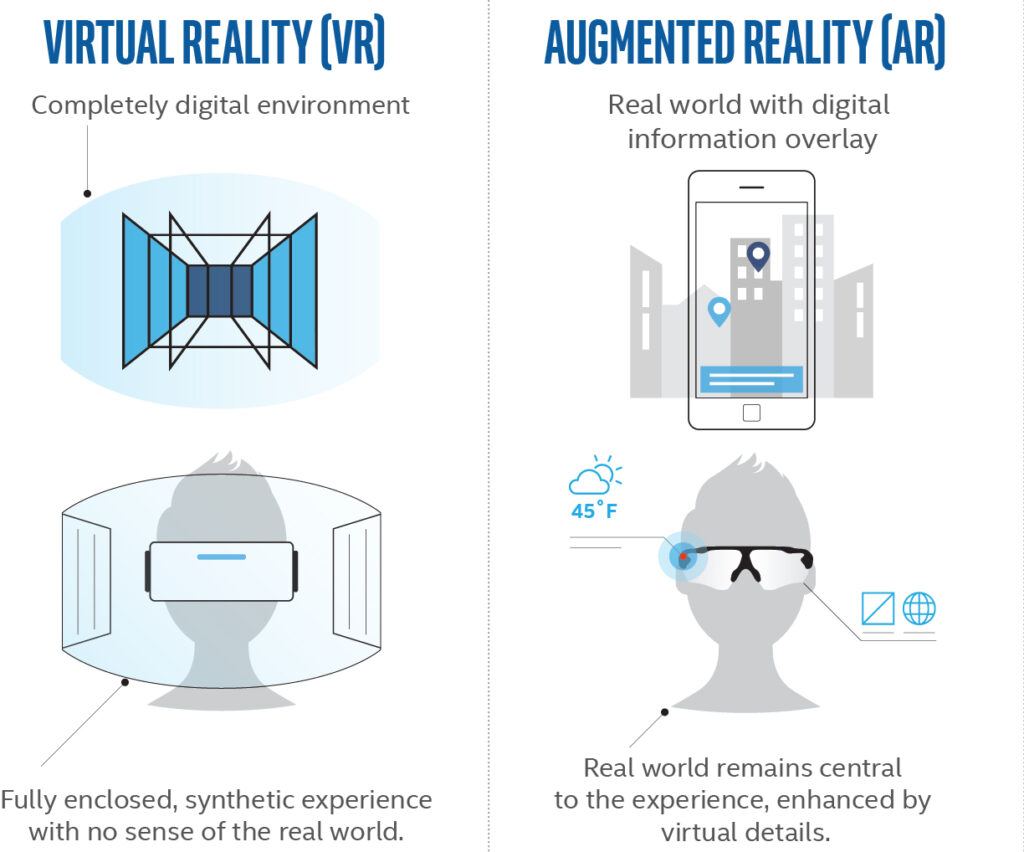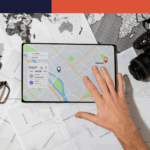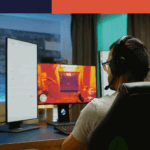Written by Praven Kumar and Dr. Kristen Stevenson
How often have you heard, “This is boring. Why do I have to learn this?” in your classroom or training session? Wouldn’t you rather hear, “This is so cool! It feels like I am in the moment.”
There are many times when the connection between theory and practice in a classroom or training session is completely lost because the content feels dull. This is where virtual reality (VR) or augmented reality (AR) can transform and enhance your students’ learning experiences. In this post, we will explore how VR and AR differentiate, how they can be used in e-learning, their benefits and challenges of implementation, future trends, and case studies.
Understanding VR and AR

VR provides immersive, computer-generated environments for exploring and interacting. Best achieved using headsets with motion-tracking technology, VR technology works best in environments where learners must participate in active learning and practical engagement to master skills (Conrad et al., 2024). The immersive experience significantly boosts learning by increasing student involvement, retaining more information, and enhancing skill acquisition (Familoni & Onyebuchi, 2024).
Whereas AR overlays computer-generated content onto our real-world surroundings, enriching our environment (Hantano et. al., 2018). This highly interactive technique lets you determine if a product or service will work for you. For example, if you have ever used the ColorSnap® Visualizer from Sherwin Williams to see what your kitchen will look like with a new paint color or IKEA home design to see if the new couch will fit in the living room, then you have experienced AR.
Applications in eLearning
Virtual labs allow students to perform experiments and explore scientific concepts without needing physical lab facilities. VR is essential within the healthcare industry, offering a simulated environment where healthcare professionals can practice and refine their skills. This virtual setting is critical to improving their abilities and ensuring they can apply their knowledge more effectively in actual situations. In a parallel way, AR can make learning about history more engaging by overlaying relevant historical details, images, and videos onto real-world views. This approach offers hands-on and engaging educational experiences for history enthusiasts and travelers.
Moreover, VR and AR technologies enable skills training in various industries by mimicking real-life job situations. This allows individuals to practice safely, increasing their confidence when using new products or tools. These modern methods significantly enhance learning by making the experience more immersive, which leads to better engagement, information retention, and skill acquisition.
Benefits of VR and AR in eLearning
VR and AR technologies excel in capturing learners’ attention through their immersive experiences, significantly reducing distractions and fostering active participation. This immersive approach not only keeps learners engaged but also dramatically improves the rate at which they retain information, thanks to the memorable nature of the experience. Efforts have been made to ensure that these training platforms are accessible to individuals with various abilities, ensuring everyone can have a similar enriching experience, regardless of physical limitations. Such inclusivity is vital in adequately preparing learners for real-life scenarios and challenges they might face. Additionally, the global reach of VR and AR technologies allows for worldwide knowledge dissemination, breaking down geographical barriers. This global accessibility means that anyone with an internet-connected computer or digital device can access these learning tools, making education and training more universally available.
Challenges and Considerations Before Using VR or AR
Investing in VR and AR technologies can be expensive. The costs involve purchasing the required hardware and developing custom content tailored to educational or training needs. Additionally, to fully experience VR and AR, users need devices compatible with these technologies and a stable internet connection, which might not be accessible to everyone. Creating content for VR and AR is also a complex and time-consuming process. It requires developers who have specific skills and expertise to ensure the content is of high quality. This development process demands an extensive investment of time and resources.
Future Trends and Outlook
The evolution of virtual and augmented technologies continuously enhances the landscape of learning and technology. These advancements improve the equipment and features associated with VR and AR and facilitate an ongoing enhancement of the learning experience. Artificial intelligence (AI) integration is further bolstered by this, significantly personalizing learning. AI allows for modifying learning content in real-time, tailoring it to user preferences while providing live feedback and guidance, making the educational journey more effective and engaging. Additionally, VR and AR technologies have opened new avenues for collaborative learning. They enable instructors to effortlessly present content to a global audience, fostering an environment where learners can communicate and collaborate seamlessly. This collective learning approach, facilitated by cutting-edge technologies, paves the way for a more interactive and immersive educational experience.
Case Studies and Success Stories
The impact of VR and AR on e-learning is best understood through real-world examples. The following case studies and success stories showcase the transformative power of these innovative technologies.
- Holorooms, implemented by Lowes, has VR simulations for its home improvement projects. Now, customers can use VR headsets to envision how the products they are about to purchase could benefit their homes. This considerably improves the customers’ shopping experience and is a valuable training tool for its employees to understand product offerings better.
- The Human Fusions Institute has developed technologies primarily to benefit individuals with disabilities. Their engineer, Michael Fu, PhD, and his team have used VR and AR technologies to rehabilitate people who suffer neurological injuries such as strokes or conditions such as cerebral palsy. Electrodes are placed on an individual’s hands, which converts electrostimulation into haptic interfaces, allowing the patient to sense pressure and skin texture. This incredibly benefits the patients by improving their quality of life.
- Johns Hopkins School of Nursing uses a VR avatar to train pre-licensure and advanced practice students. The virtual simulation platform was rolled out over the summer, during the COVID pandemic, and was able to train about 400 students in a short time frame. Oxford Medical Simulation, a Boston-based company, designed the VR software.
Conclusion
VR and AR technologies are promising and offer great flexibility and inclusivity to their users. While they may be initially challenging to implement, the return on investment is worth it due to their high success rate. This revolutionary technology continues to evolve, and the educational landscape will continually experience its benefits in the future.
Watch our webinar with Farah Allen as she presents information on both technologies!
References
- Conrad, M., Kablitz, D., & Schumann, S. (2024). Learning effectiveness of immersive virtual reality in education and training: A systematic review of findings. Computers & Education: X Reality, 4. https://doi.org/10.1016/j.cexr.2024.100053
- Familoni, B. T. & Onyebuchi, N. C. (2024). Augmented and virtual reality in U.S. education: A review: Analyzing the impact, effectiveness, and future prospects of AR/VR tools in enhancing learning experiences. International Journal of Applied Research in Social Sciences, 6(4). https://doi.org/10.51594/ijarss.v6i4.1043
- Hantano, B. S., Nugroho, L. E., & Santosa, P.I. (2018, July 24-26). Meta-review of augmented reality in education. In 2018 10th International Conference on Information Technology and Electrical Engineering (ICITEE), 312-315. https://doi.org/ICITEED.2018.8534888
- IKEA. (2024). IKEA Kreativ: Bring your ideal home to life. ikea.com. https://www.ikea.com/us/en/home-design/
Sherwin Williams. (2024). ColorSnap. Sherwin-Williams.com. https://www.sherwin-williams.com/en-us/color/color-tools/colorsnap-experience








